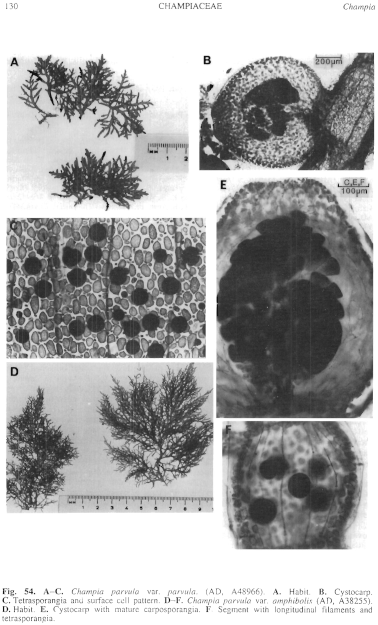|
|
|
|
|
|||||||||||
|
Electronic Flora of South Australia Species Fact Sheet
Phylum Rhodophyta – Class Florideophyceae – Order Rhodymeniales – Family Champiaceae
Thallus (Fig. 54A) red-brown, 2–4 cm high, spreading, moderately branched irregularly radially to suboppositely, main branches 1–1.5 mm in diameter, branchlets 0.5–1 mm in diameter. Holdfast discoid; epilithic. Structure multiaxial, with 10–15 apical cells, developing a cortex of angular cells (15–) 20–50 (–60) µm across and L/B (1–) 1.5–2 (–3), with small cells cut off from their corners, sparse on younger branches, more frequent on older axes; longitudinal filaments peripheral only, usually with two (–3) complete cells (with secretory cells) and two part cells between the diaphragms; hairs common. Rhodoplasts discoid, usually in chains.
Reproduction: Gametangial thalli dioecious. Carposporophyte with a basal fusion cell, branched gonimoblast filaments of ovoid cells and terminal ovoid to obconical, carposporangia (40–) 50–90 µm in diameter. Basal nutritive tissue slight, inner cells of pericarp stellate and separating. Cystocarps (Fig. 54B) scattered, subspherical to urceolate, 0.7–1.0 (–1.3) mm in diameter, pericarp 60–130 µm and 3–5 cells thick, ostiolate. Spermatangia covering segments near apices of young branches, cut off from branched filaments of initials, ovoid, 3–5 µm in diameter.
Tetrasporangia (Fig. 54C) scattered, transformed from cortical cells, (50–) 60–120 µm in diameter, tetrahedrally divided.
Type from Cadiz, Spain; lectotype in Herb. Agardh, LD, 26022.
Selected specimens: Muston, American R. inlet, Kangaroo I., S. Aust., 3–4 m deep (Shepherd, 29.xii.1977; AD, A48966).
Distribution: Widely reported from most temperate waters, but many records need verification. Reedman & Womersley (1976, p. 91) listed several dubious references to the species in southern Australia, and it has recently been recorded from N.S.W. by Millar & Kraft (1993, p. 29). However one collection appears to agree with the type variety.
Taxonomic notes: The above description is based on the Muston specimen.
References:
MILLAR, A.J.K. & KRAFT, G.T. (1993). Catalogue of Marine and Freshwater Red Algae (Rhodophyta) of New South Wales, including Lord Howe Island, South-western Pacific. Aust. Syst. Bot. 6, 1–90.
REEDMAN, D.J. & WOMERSLEY, H.B.S. (1976). Southern Australian species of Champia and Chylocladia (Rhodyméniales: Rhodophyta). Trans. R. Soc. S. Aust. 100, 75–104.
The Marine Benthic Flora of Southern Australia Part IIIB complete list of references.
Publication:
Womersley, H.B.S. (28 June, 1996)
The Marine Benthic Flora of Southern Australia
Rhodophyta. Part IIIB. Gracilarialse, Rhodymeniales, Corallinales and Bonnemaisoniales
Reproduced with permission from The Marine Benthic Flora of Southern Australia Part IIIB 1996, by H.B.S. Womersley. Australian Biological Resources Study, Canberra. Copyright Commonwealth of Australia.
Illustration in Womersley Part IIIA, 1996: FIG. 54 A–C.

Figure 54 enlarge
Fig. 54. A–C. Champia parvula var. parvula. (AD, A48966). A. Habit. B. Cystocarp. C. Tetrasporangia and surface cell pattern. D–F. Champia parvula var. amphibolis (AD, A38255). D. Habit. E. Cystocarp with mature carposporangia. F. Segment with longitudinal filaments and tetrasporangia.

|
Email Contact: State Herbarium of South Australia |

|